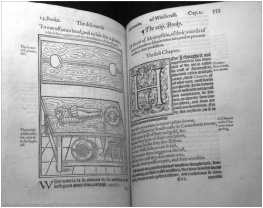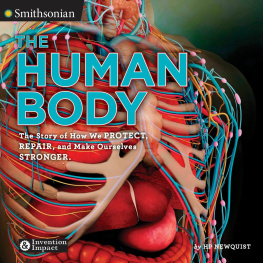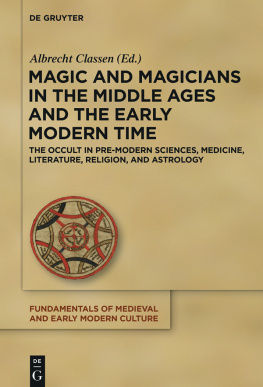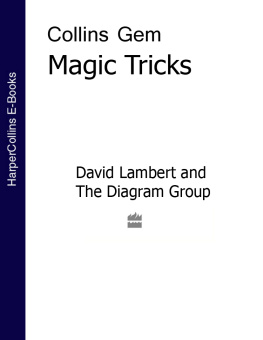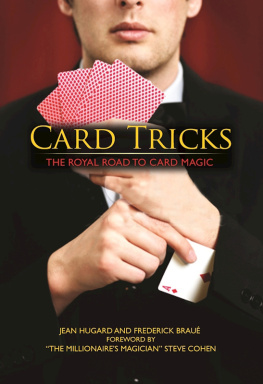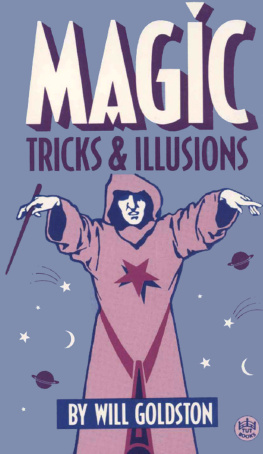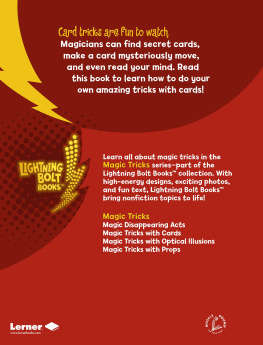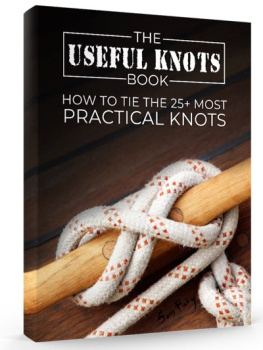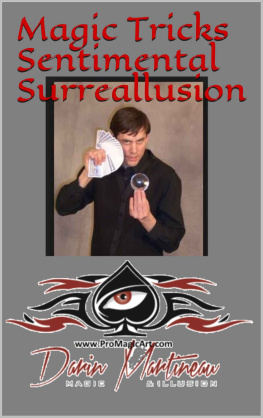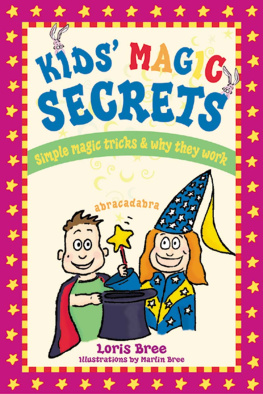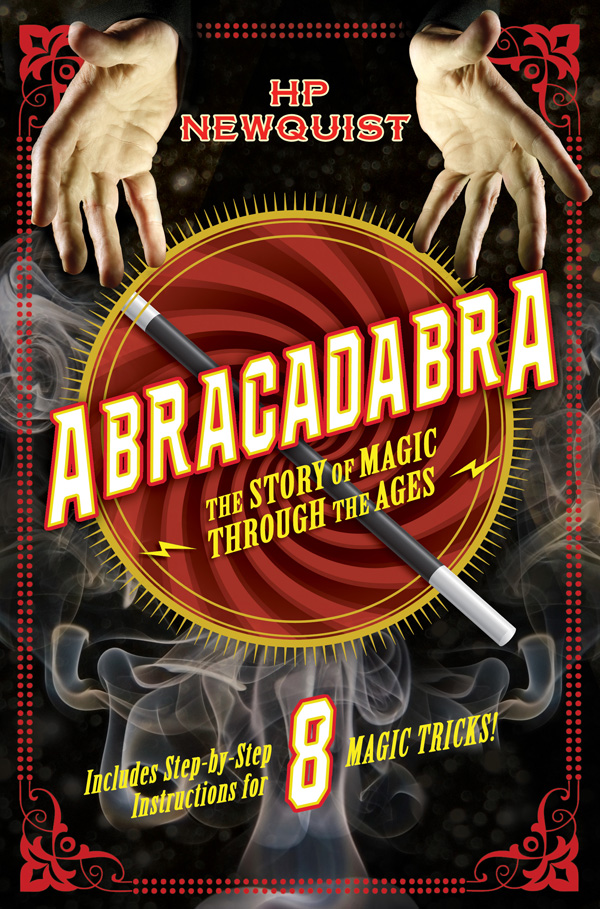Contents
Guide

The author and publisher have provided this e-book to you for your personal use only. You may not make this e-book publicly available in any way. Copyright infringement is against the law. If you believe the copy of this e-book you are reading infringes on the authors copyright, please notify the publisher at: us.macmillanusa.com/piracy.
TO MY FRIENDS
and you know who you are.
Because having good friends is
an extraordinarily magical thing.
Magic is a word that has been used throughout history. People used it for centuries to describe things they saw but didnt understand. Magic was the explanation for earthquakes and insect plagues and floods. Even as mankind moved into modern times, people who saw engines and telephones and radios and electrical appliances for the first time thought they were seeing magic at work.
Today magic still describes things we see yet cannot understand. Now, however, it applies to entertainment. Magicians are able to perform tricks that cause us to doubt what we think is possible and what is not. They can do this by having us pick a cardany cardand telling us what it is even while theyre blindfolded. Or they can put on a huge stage show complete with animals, lights, characters, smoke, mirrors, and loud music and make people disappear right in front of our eyes.
Magic is deception. Good magic fools us so completely that we dont feel like we have been tricked or deceived. Instead we feel like we have seen the impossibleseen something that we cannot explain, something amazing.
Magicians have no special powers. They are not wizards or gods or supernatural beings or aliens. Magicians are people with very specific skillsjust as doctors have skills, and acrobats have skills. The magicians skills allow him or her to do things most of us cannot do. A magician can saw a human being in half and then put the two pieces back together. A magician can tear up our favorite photograph, throw it in the garbage, and then pull that same photo out of an envelope in their pocketin perfect condition. A magician can be handcuffed and chained inside a tank of water and escape in the time it takes to count to three.
Believe it or not, there are only a few types of magic. Most magic falls into one of five categories. Within those categories, though, there are hundreds, even thousands, of tricks.
The first category of magic is called Sleight of Hand. It is also known as prestidigitation, which means the quick movement of fingers. In Sleight of Hand, a magician uses their fingers and hands to make everyday objects disappear, change position, or transform from one thing into another. These objects can be coins, cards, handkerchiefs, scarves, keys, watches, cell phones, or any other small item that can fit into the hand.
The second category is called Conjuring. This is when a magician makes something appear out of nowhere, such as pulling a rabbit out of a hat or making a person appear from an empty box. Conjurers can also make any number of things disappear, and over the years this has included everything from elephants to airplanes.
The third category is Illusion. This is one of the most complicated forms of magic. Illusion involves making an audience believe it is seeing something other than what is actually happening. It usually takes place on a stage and involves special equipment. Sawing a person in half, floating in the air, and walking on water are all forms of Illusion.
A fourth category of magic is Escaping. Called Escapology, it involves magicians getting out of seemingly inescapableand oftentimes dangeroussituations. These situations range from being tied to a chair or locked in handcuffs to being encased in a sealed tank of water or chained inside a cage.
Finally there is Mentalism, also known as Mind Reading. Mentalists are the magicians who seem able to predict the future or guess what people are thinking or tell people secret things about themselves that no one else knows.
Good magicians are masters at encouraging a suspension of disbelief. This means you start out disbelieving something is possible, but you are persuaded to change your mind, and possibly start believing after all. If I told you that I could saw someone in half, you wouldnt believe it. But if I showed you I could do it as part of a magic act, youd probably change your mind. Youd put asideor suspendyour disbelief.
The best magicians do more than get us to suspend our disbelief. They leave us shaking our heads and wondering, How did they do that? In most cases, well never know how they did it. But as youll find in the pages to come, sometimes you will get the answers.
Magicians werent born with the knowledge of how to perform magic. Someone had to teach them how to do their tricks. And before that, someone had to create the tricks. After all, magic tricks and illusions didnt just appear out of thin air. Someone had to figure out what they wanted a trick to be, then how to perform it, and then make it so amazing that it would fool everyone.
So who came up with these magic tricks?
For the answer to that, we have to go back through history. We have to go back a few thousand years, because it turns out that people have been doing magic for a very, very long time.
There is one magic trick that has been performed more than any other in history. This trick is performed by all kinds of magicians, whether they are on a big Las Vegas stage or sitting at a small table on a city sidewalk. Called Cups and Balls, it is a very simple sleight of hand trick. The magician hides balls under cups, then moves the cups around on a tabletop. When he lifts the cups, the balls have magically switched places or disappeared.
Some magicians believe that Cups and Balls is the oldest magic trick in the world. They claim there is evidence of it being performed in ancient Egypt. They point to a cemetery called Beni Hasan, located along the banks of the Nile River. The cemetery contains thirty-nine tombsmany of which are four thousand years oldcarved out of the rock hills. The cemetery is historically important because the walls of the tombs were painted with scenes of ancient Egyptian life and contain numerous ancient picture symbols called hieroglyphs.
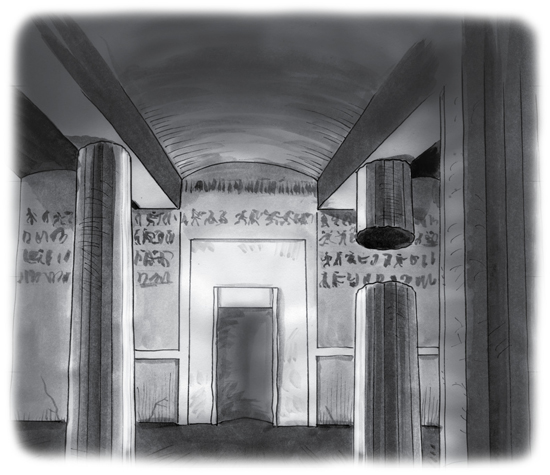
The tombs of Beni Hasan
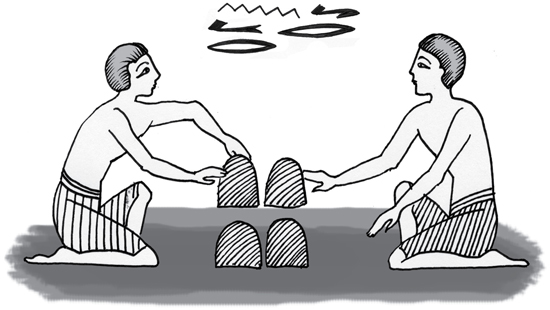
Cups and Balls
What makes the Beni Hasan cemetery important to our story is that there is one scene painted on a wall that shows two people facing each other. The people appear to be moving cups in the same way that modern magicians do with Cups and Balls. While no one knows for sure, many magicians believe that this painting shows Egyptians performing Cups and Ballsmore than forty centuries ago.
Ancient Egypt is home to many mysteries and legends, from the Sphinx and the building of the pyramids to the stories of King Tut and Cleopatra. But some of its most incredible legends were about magic and about men who may have been the first magicians. These stories were depicted in hieroglyphs on an Egyptian document known as the Westcar Papyrus, which was written more than three thousand years ago. In one story, an advisor to the Egyptian pharaoh makes a crocodile out of wax. When he throws the wax crocodile into the water, it magically comes alive as a real crocodile.

